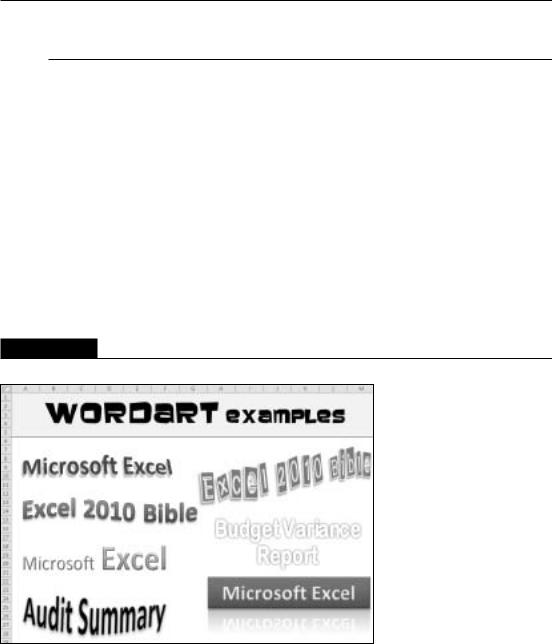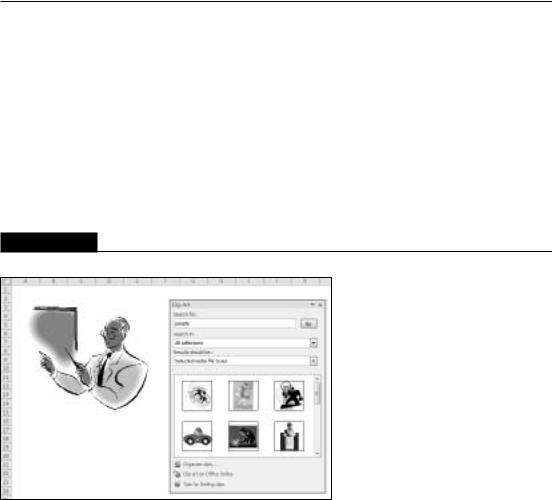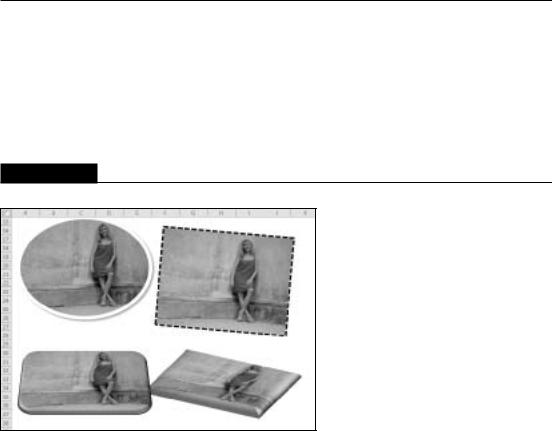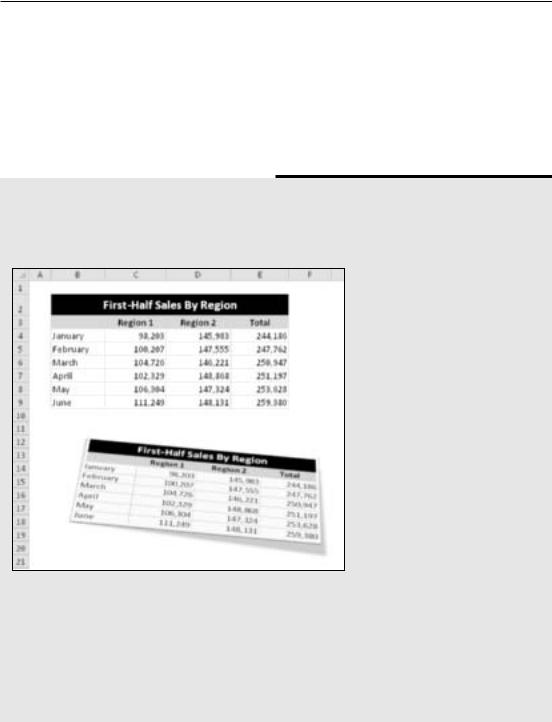
- •About the Author
- •About the Technical Editor
- •Credits
- •Is This Book for You?
- •Software Versions
- •Conventions This Book Uses
- •What the Icons Mean
- •How This Book Is Organized
- •How to Use This Book
- •What’s on the Companion CD
- •What Is Excel Good For?
- •What’s New in Excel 2010?
- •Moving around a Worksheet
- •Introducing the Ribbon
- •Using Shortcut Menus
- •Customizing Your Quick Access Toolbar
- •Working with Dialog Boxes
- •Using the Task Pane
- •Creating Your First Excel Worksheet
- •Entering Text and Values into Your Worksheets
- •Entering Dates and Times into Your Worksheets
- •Modifying Cell Contents
- •Applying Number Formatting
- •Controlling the Worksheet View
- •Working with Rows and Columns
- •Understanding Cells and Ranges
- •Copying or Moving Ranges
- •Using Names to Work with Ranges
- •Adding Comments to Cells
- •What Is a Table?
- •Creating a Table
- •Changing the Look of a Table
- •Working with Tables
- •Getting to Know the Formatting Tools
- •Changing Text Alignment
- •Using Colors and Shading
- •Adding Borders and Lines
- •Adding a Background Image to a Worksheet
- •Using Named Styles for Easier Formatting
- •Understanding Document Themes
- •Creating a New Workbook
- •Opening an Existing Workbook
- •Saving a Workbook
- •Using AutoRecover
- •Specifying a Password
- •Organizing Your Files
- •Other Workbook Info Options
- •Closing Workbooks
- •Safeguarding Your Work
- •Excel File Compatibility
- •Exploring Excel Templates
- •Understanding Custom Excel Templates
- •Printing with One Click
- •Changing Your Page View
- •Adjusting Common Page Setup Settings
- •Adding a Header or Footer to Your Reports
- •Copying Page Setup Settings across Sheets
- •Preventing Certain Cells from Being Printed
- •Preventing Objects from Being Printed
- •Creating Custom Views of Your Worksheet
- •Understanding Formula Basics
- •Entering Formulas into Your Worksheets
- •Editing Formulas
- •Using Cell References in Formulas
- •Using Formulas in Tables
- •Correcting Common Formula Errors
- •Using Advanced Naming Techniques
- •Tips for Working with Formulas
- •A Few Words about Text
- •Text Functions
- •Advanced Text Formulas
- •Date-Related Worksheet Functions
- •Time-Related Functions
- •Basic Counting Formulas
- •Advanced Counting Formulas
- •Summing Formulas
- •Conditional Sums Using a Single Criterion
- •Conditional Sums Using Multiple Criteria
- •Introducing Lookup Formulas
- •Functions Relevant to Lookups
- •Basic Lookup Formulas
- •Specialized Lookup Formulas
- •The Time Value of Money
- •Loan Calculations
- •Investment Calculations
- •Depreciation Calculations
- •Understanding Array Formulas
- •Understanding the Dimensions of an Array
- •Naming Array Constants
- •Working with Array Formulas
- •Using Multicell Array Formulas
- •Using Single-Cell Array Formulas
- •Working with Multicell Array Formulas
- •What Is a Chart?
- •Understanding How Excel Handles Charts
- •Creating a Chart
- •Working with Charts
- •Understanding Chart Types
- •Learning More
- •Selecting Chart Elements
- •User Interface Choices for Modifying Chart Elements
- •Modifying the Chart Area
- •Modifying the Plot Area
- •Working with Chart Titles
- •Working with a Legend
- •Working with Gridlines
- •Modifying the Axes
- •Working with Data Series
- •Creating Chart Templates
- •Learning Some Chart-Making Tricks
- •About Conditional Formatting
- •Specifying Conditional Formatting
- •Conditional Formats That Use Graphics
- •Creating Formula-Based Rules
- •Working with Conditional Formats
- •Sparkline Types
- •Creating Sparklines
- •Customizing Sparklines
- •Specifying a Date Axis
- •Auto-Updating Sparklines
- •Displaying a Sparkline for a Dynamic Range
- •Using Shapes
- •Using SmartArt
- •Using WordArt
- •Working with Other Graphic Types
- •Using the Equation Editor
- •Customizing the Ribbon
- •About Number Formatting
- •Creating a Custom Number Format
- •Custom Number Format Examples
- •About Data Validation
- •Specifying Validation Criteria
- •Types of Validation Criteria You Can Apply
- •Creating a Drop-Down List
- •Using Formulas for Data Validation Rules
- •Understanding Cell References
- •Data Validation Formula Examples
- •Introducing Worksheet Outlines
- •Creating an Outline
- •Working with Outlines
- •Linking Workbooks
- •Creating External Reference Formulas
- •Working with External Reference Formulas
- •Consolidating Worksheets
- •Understanding the Different Web Formats
- •Opening an HTML File
- •Working with Hyperlinks
- •Using Web Queries
- •Other Internet-Related Features
- •Copying and Pasting
- •Copying from Excel to Word
- •Embedding Objects in a Worksheet
- •Using Excel on a Network
- •Understanding File Reservations
- •Sharing Workbooks
- •Tracking Workbook Changes
- •Types of Protection
- •Protecting a Worksheet
- •Protecting a Workbook
- •VB Project Protection
- •Related Topics
- •Using Excel Auditing Tools
- •Searching and Replacing
- •Spell Checking Your Worksheets
- •Using AutoCorrect
- •Understanding External Database Files
- •Importing Access Tables
- •Retrieving Data with Query: An Example
- •Working with Data Returned by Query
- •Using Query without the Wizard
- •Learning More about Query
- •About Pivot Tables
- •Creating a Pivot Table
- •More Pivot Table Examples
- •Learning More
- •Working with Non-Numeric Data
- •Grouping Pivot Table Items
- •Creating a Frequency Distribution
- •Filtering Pivot Tables with Slicers
- •Referencing Cells within a Pivot Table
- •Creating Pivot Charts
- •Another Pivot Table Example
- •Producing a Report with a Pivot Table
- •A What-If Example
- •Types of What-If Analyses
- •Manual What-If Analysis
- •Creating Data Tables
- •Using Scenario Manager
- •What-If Analysis, in Reverse
- •Single-Cell Goal Seeking
- •Introducing Solver
- •Solver Examples
- •Installing the Analysis ToolPak Add-in
- •Using the Analysis Tools
- •Introducing the Analysis ToolPak Tools
- •Introducing VBA Macros
- •Displaying the Developer Tab
- •About Macro Security
- •Saving Workbooks That Contain Macros
- •Two Types of VBA Macros
- •Creating VBA Macros
- •Learning More
- •Overview of VBA Functions
- •An Introductory Example
- •About Function Procedures
- •Executing Function Procedures
- •Function Procedure Arguments
- •Debugging Custom Functions
- •Inserting Custom Functions
- •Learning More
- •Why Create UserForms?
- •UserForm Alternatives
- •Creating UserForms: An Overview
- •A UserForm Example
- •Another UserForm Example
- •More on Creating UserForms
- •Learning More
- •Why Use Controls on a Worksheet?
- •Using Controls
- •Reviewing the Available ActiveX Controls
- •Understanding Events
- •Entering Event-Handler VBA Code
- •Using Workbook-Level Events
- •Working with Worksheet Events
- •Using Non-Object Events
- •Working with Ranges
- •Working with Workbooks
- •Working with Charts
- •VBA Speed Tips
- •What Is an Add-In?
- •Working with Add-Ins
- •Why Create Add-Ins?
- •Creating Add-Ins
- •An Add-In Example
- •System Requirements
- •Using the CD
- •What’s on the CD
- •Troubleshooting
- •The Excel Help System
- •Microsoft Technical Support
- •Internet Newsgroups
- •Internet Web sites
- •End-User License Agreement

Part III: Creating Charts and Graphics
Using WordArt
WordArt is available in previous versions of Excel, but this feature got a well-needed facelift in Excel 2007. You can use WordArt to create graphical effects in text. Figure 22.14 shows a few examples of WordArt.
To insert a WordArt graphic on a worksheet, choose Insert WordArt and then select a style from the gallery. Excel inserts an object with the placeholder text Your text here. Replace that text with your own, resize it, and apply other formatting if you like.
When you select a WordArt image, Excel displays its Drawing Tools contextual menu. Use the controls to vary the look of your WordArt.
Note
The controls in the Drawing Tools Format Shape Styles group operate on the Shape that contains the text — not the text. To apply text formatting, use the controls in the Drawing Tools Format WordArt
Styles group. You can also use some of the standard formatting controls on the Home tab or the Mini toolbar. In addition, right-click the WordArt and choose Format Text Effects for more formatting options. n
FIGURE 22.14
WordArt examples.
530

Chapter 22: Enhancing Your Work with Pictures and Drawings
Working with Other Graphic Types
Excel can import a wide variety of graphics into a worksheet. You have several choices:
•Use the Clip Art task pane to locate and insert an image.
•Import a graphic file directly.
•Copy and paste an image using the Windows Clipboard.
About graphics files
Graphics files come in two main categories: bitmap and vector (picture).
•Bitmap images are made up of discrete dots. They usually look pretty good at their original size, but often lose clarity if you increase the size. Examples of common bitmap file formats include BMP, PNG, JPEG, TIFF, and GIF.
•Vector-based images, on the other hand, are comprised of points and paths that are represented by mathematical equations, so they retain their crispness regardless of their size. Examples of common vector file formats include CGM, WMF, and EPS.
You can find hundreds of thousands of graphics files free for the taking on the Internet. Be aware, however, that some graphic files have copyright restrictions.
Caution
Using bitmap graphics in a worksheet can dramatically increase the size of your workbook, resulting in more memory usage and longer load and save times. n
Using the Clip Art task pane
Clip art refers to pre-made images (as opposed to custom image) that are used to illustrate just about any medium. The term originated back in the days when images were actually clipped from books and reused in new print projects. Nowadays, clip art is almost always in electronic form.
Want a Great Graphics File Viewer?
Many users are content to use the graphics file-viewing capabilities built into Windows. If you do a lot of work with graphics files, though, you owe it to yourself to get a real file-viewing program.
Many graphics viewers are available, but one of the best products in its class is IrfanView. It enables you to view just about any graphics file you can find, and it has features and options that will satisfy even hard-core graphics mavens. Best of all, it’s free. To download a copy, visit www.irfanview.com.
531

Part III: Creating Charts and Graphics
Microsoft Office includes lots of clip art images, and you access them via the Clip Art task pane. This task pane provides an easy way to locate and insert images into a worksheet.
Note
The Clip Art task pane also allows you to insert sound and video files, and gives you direct access to the Microsoft Design Gallery Live on the Web. n
Display the Clip Art task pane by choosing Insert Clip Art. You can search for clip art by using the controls at the top of the task pane. Figure 22.15 shows the task pane, along with the thumbnail images resulting from a search for “people”. To insert an image into the active worksheet, just double-click the thumbnail. For additional options, right-click the thumbnail image.
FIGURE 22.15
Use the Clip Art task pane to search for clip art and other multimedia files.
If you can’t find a suitable image, go online and browse through the extensive clip art at the Microsoft Clip Gallery Live Web site. Click the Find More at Office.com link (at the bottom of the task pane), and your Web browser will be activated, at which point you can view the images (or listen to the sounds) and add those you want to your Clip Organizer.
Inserting graphics files
If the graphic image that you want to insert is available in a file, you can easily import the file into your worksheet. Choose Insert Picture. Excel displays its Insert Picture dialog box, from which you can browse for the file.
532

Chapter 22: Enhancing Your Work with Pictures and Drawings
When you insert a picture on a worksheet, you can modify the picture in a number of ways from the Picture Tools Format contextual tab, which becomes available when you select a picture object. For example, you can adjust the color, contrast, and brightness. In addition, you can add borders, shadows, reflections, and so on — similar to the operations available for Shapes.
And don’t overlook the Picture Tools Format Picture Styles group. These commands can transform your image in some very interesting ways. Figure 22.16 shows various styles for a picture.
FIGURE 22.16
Displaying a picture in a number of different styles.
New Feature
A new feature in Office 2010 is Artistic Effects. This command can apply a number of Photoshop-like effects to an image. To access this feature, right-click and image and choose Format Picture. Then, in the Format Picture dialog box, choose Artistic Effects. Each effect is somewhat customizable, so if you’re not happy with the default effect, try adjusting some options.
You might be surprised by some of the image enhancements that are available. The best way to learn this feature is to dig in and experiment. Even if you have no need for image enhancement, you might find that it’s a fun diversion when you need a break from working with numbers. n
Inserting screenshots
A new feature in Excel 2010 allows you to insert an image of any program currently running on your computer. To use the new screenshot feature
533

Part III: Creating Charts and Graphics
1.Make sure that the window you want to use displays the content that you want.
2.Choose Insert Illustrations Shapes. You’ll see a gallery that contains thumbnails of all windows open on your computer.
3.Click the image you want. Excel inserts it into your worksheet.
When the image is selected, you can use any of the normal picture tools.
Taking Pictures of Ranges
One of Excel’s best-kept secrets is its ability to copy and paste “live” pictures of cells and charts. You can copy a cell or range and then paste a picture (as an object) of the cell or range on any worksheet or chart. If you change the contents of a cell that’s in a picture, the picture changes. The accompanying image shows a picture of a range after applying some picture effects.
To “take a picture” of a range
1.Select the range.
2.Press Ctrl+C to copy the range.
3.Activate another cell.
4.Choose Home Clipboard Paste Linked Picture (I).
The result is a live picture of the range you selected in Step 1.
534
